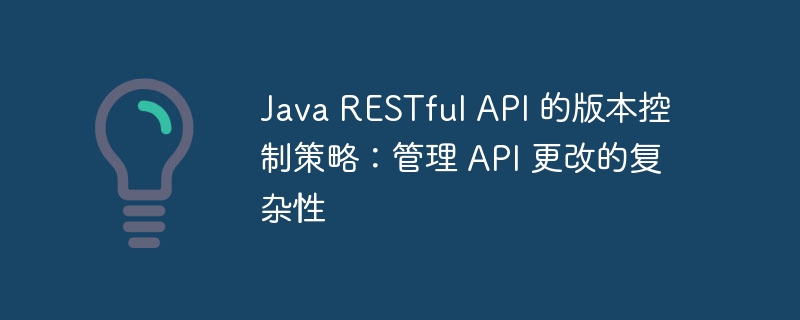

Java RESTful API version control is an important part of the API development process. A reasonable version control strategy can help the development team better manage the complexity of API changes. In actual projects, how to design and choose a suitable version control strategy is crucial. This article discusses the version control strategy of Java RESTful API from different angles to help developers better cope with the challenges brought by API changes.
Different version control strategies
/api/v1 and /api/v2. This provides a simple way to differentiate between different versions of the API, but can result in a large number of duplicate URLs. /api/vers<strong class="keylink">io</strong>n1 and /api/version2. This eliminates URL duplication, but it can be difficult to distinguish between different versions of the endpoint, especially if they coexist under the same path. Accept: application/<strong class="keylink">JSON</strong>; version=v1. This provides a flexible way to specify versions, but requires the client to set the header on every request. ?version=v1. This is similar to the request header approach, but is simpler and requires no additional processing on the server side. application/<strong class="keylink">js</strong>on; version=v1 and application/json; version=v2. This provides rich metadata but requires the client to support media type negotiation. Best Practices
Clear documentation: Comprehensively document your version control strategy, including how to use it, handle version changes, and the deprecation process. Backwards Compatibility: When backward-incompatible changes are introduced, provide a transition period to give existing clients a chance to upgrade. Version deprecation: When a version is no longer supported, gradually deprecate it and provide sufficient notification time. Use version control tools: Use version control tools , such as git, to track API changes and manage different versions. Continuous Monitoring: Monitor API usage and make adjustments as needed to ensure optimal performance and security.
Sample code
The following example shows the use of version number strategy in Spring Boot API:
@RestController
@RequestMapping("/api")
public class ApiController {
@GetMapping("/v1/users")
public List<User> getUsersV1() {
// Implementation for API version 1
}
@GetMapping("/v2/users")
public List<User> getUsersV2() {
// Implementation for API version 2
}
}in conclusion
Implementing an effective versioning strategy is critical for managing changes in Java RESTful APIs. By choosing strategies carefully and following best practices, developers can ensure that their APIs evolve smoothly and in a controlled manner to meet changing business needs.
The above is the detailed content of Versioning strategies for Java RESTful APIs: Managing the complexity of API changes. For more information, please follow other related articles on the PHP Chinese website!
 How to delete the last blank page in word
How to delete the last blank page in word
 How to solve the problem of invalid database object name
How to solve the problem of invalid database object name
 wps replacement shortcut keys
wps replacement shortcut keys
 win10 connect to shared printer
win10 connect to shared printer
 Solution to WIN10 update failure
Solution to WIN10 update failure
 What are the methods to change password in MySQL?
What are the methods to change password in MySQL?
 The difference between scilab and matlab
The difference between scilab and matlab
 What are the data storage methods?
What are the data storage methods?




